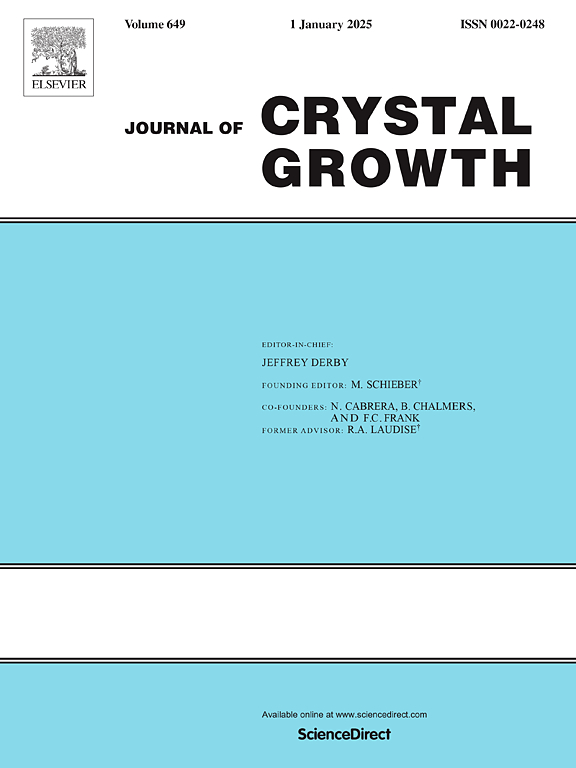Point-seed-oriented and partial shape-restricted growth of KDP crystals: Numerical simulation and experimental study
IF 2
4区 材料科学
Q3 CRYSTALLOGRAPHY
引用次数: 0
Abstract
Numerical simulations are performed to understand the mass transfer in point-seed-oriented and partial shape-restricted growth of potassium dihydrogen phosphate (KDP) crystals. A type-II cut point-seed is positioned in between two parallel and rotating platforms separated by a fixed distance. Numerical simulations show that the periodic rotational motion of the two adjacent parallel platforms can lead to significant differences in surface supersaturation across the same prismatic face. The non-steady and non-laminate flow result in defects such as growth avoids and inclusions that seriously affect the optical properties of the crystal. In some cases, it results in the failure of the growth (i.e., significant cracks). Lack of surface supersaturation homogeneity results in significant difference in step-motion rates and in the step-slope, which further cause step bending and even the formation of macroscopic steps. Inclusions and avoids are often filled with solution trapped in gaps between macroscopic steps. We have found both experimentally and numerically that increasing the separation between the two parallel platforms to above 30 mm can significantly mitigate the supersaturation gradient on the crystal surface and drastically reduce the number of inclusion defects.
KDP晶体的点晶取向和部分形限生长:数值模拟和实验研究
通过数值模拟研究了磷酸二氢钾(KDP)晶体在点种子取向和部分形状受限生长过程中的传质过程。ii型切割点种子位于两个平行旋转平台之间,平台之间隔着固定的距离。数值模拟结果表明,两个相邻平行平台的周期性旋转运动会导致同一棱柱面表面过饱和度的显著差异。非稳定和非层叠流动导致生长避免和夹杂等缺陷,严重影响晶体的光学性能。在某些情况下,它会导致生长的失败(即明显的裂缝)。由于缺乏表面过饱和均匀性,导致台阶运动速率和台阶斜率存在显著差异,进而导致台阶弯曲,甚至形成宏观台阶。夹杂物和避免物常常充满了困在宏观台阶间隙中的溶液。我们在实验和数值上都发现,将两个平行平台之间的间距增加到30 mm以上,可以显著减轻晶体表面的过饱和梯度,并大大减少夹杂物缺陷的数量。
本文章由计算机程序翻译,如有差异,请以英文原文为准。
求助全文
约1分钟内获得全文
求助全文
来源期刊

Journal of Crystal Growth
化学-晶体学
CiteScore
3.60
自引率
11.10%
发文量
373
审稿时长
65 days
期刊介绍:
The journal offers a common reference and publication source for workers engaged in research on the experimental and theoretical aspects of crystal growth and its applications, e.g. in devices. Experimental and theoretical contributions are published in the following fields: theory of nucleation and growth, molecular kinetics and transport phenomena, crystallization in viscous media such as polymers and glasses; crystal growth of metals, minerals, semiconductors, superconductors, magnetics, inorganic, organic and biological substances in bulk or as thin films; molecular beam epitaxy, chemical vapor deposition, growth of III-V and II-VI and other semiconductors; characterization of single crystals by physical and chemical methods; apparatus, instrumentation and techniques for crystal growth, and purification methods; multilayer heterostructures and their characterisation with an emphasis on crystal growth and epitaxial aspects of electronic materials. A special feature of the journal is the periodic inclusion of proceedings of symposia and conferences on relevant aspects of crystal growth.
 求助内容:
求助内容: 应助结果提醒方式:
应助结果提醒方式:


